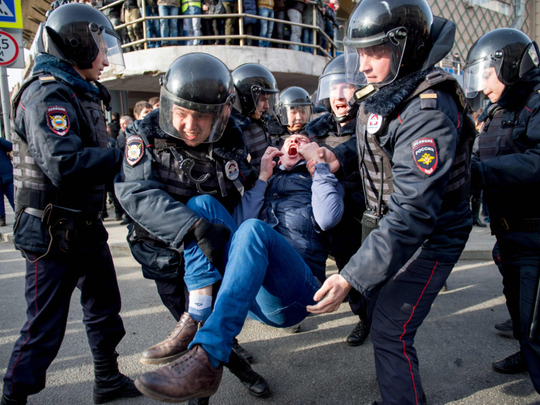
Sunday’s spate of protests in Russia were the largest outpouring of anti-Kremlin sentiment since the spate of demonstrations that gripped Moscow in the winter of 2011 to 2012. It’s too early to tell if we will see a re-run of that ultimately unsuccessful uprising. But in several ways, Sunday’s demonstrations could prove even more threatening to Russian Vladimir Putin’s grip on power.
First is the geography. Five years ago, the authorities were able — with some justification — to characterise the demonstrators who filled the capital’s boulevards and squares as members of a coddled metropolitan elite, divorced from the lives and opinions of the vast majority of Russians living beyond the Moscow ring road. After Sunday, however, that idea is dead. Demonstrations in 82 cities (by the opposition’s count), including, in no particular order, the regional capitals of Nizhny Novgorod, Novosibirsk, Yekaterinburg, and Vladivostok, drew crowds in the thousands and were organized by locals — not hipsters from Moscow.
Then there are the demographics. Journalists — and Putin’s spokesman — noticed a preponderance of 20-somethings and teenagers on Moscow’s Pushkin Square and in other cities on Sunday afternoon. It is just possible that many of these youngsters were there as an act of teenage rebellion. But the political debut of “Putin’s generation” — those with no or little memory of Russia before 2000 — signifies a profound political challenge for the Kremlin. Unlike their parents, they do not share the visceral memories of unpaid wages, currency collapse, and rampant organised crime during the “wild 1990s”, that Kremlin spin doctors have exploited brilliantly to underpin Putin’s long-term legitimacy.
What they do remember is the last three years of recession. And while they are unlikely to upend the political balance overnight (the median age in Russia is around 40), they form a conundrum that will have the Kremlin’s secret army of pollsters and social scientists working overtime. Then there is Navalny, who has spent the past five years polishing a knack for soap-box politics unmatched by almost anyone in government or opposition.
Despite being deprived of television airtime, repeatedly being hauled before a court, and generally harassed, he still manages to reach just enough of the public to make a nuisance of himself. For the past few weeks he has been campaigning in Siberia, travelling from city to city to open local headquarters for his presidential bid at next year’s elections.
Sunday’s demonstrations suggest he was not wasting his time. For a Kremlin that has worked tirelessly to root out any credible alternative from the political landscape, that must be deeply irritating — and potentially dangerous.
— The Telegraph Group Limited, London, 2017
Roland Oliphant covers Russia and the former Soviet Union from the Telegraph’s Moscow bureau.








